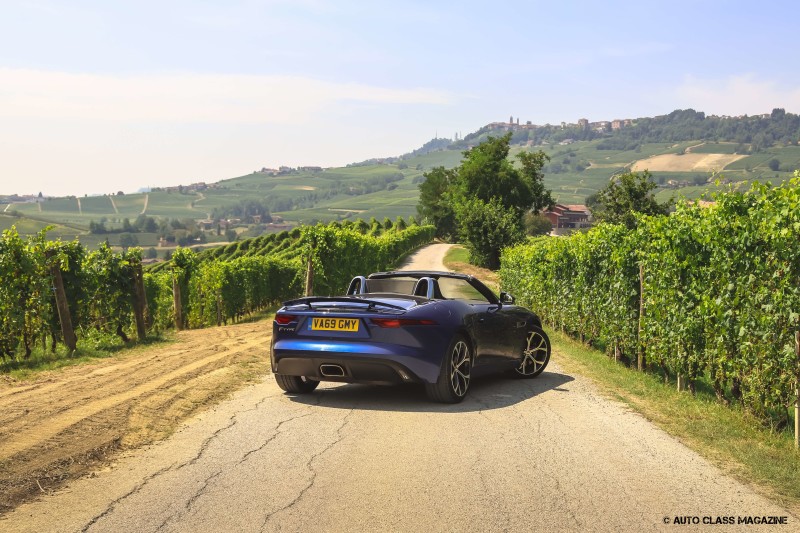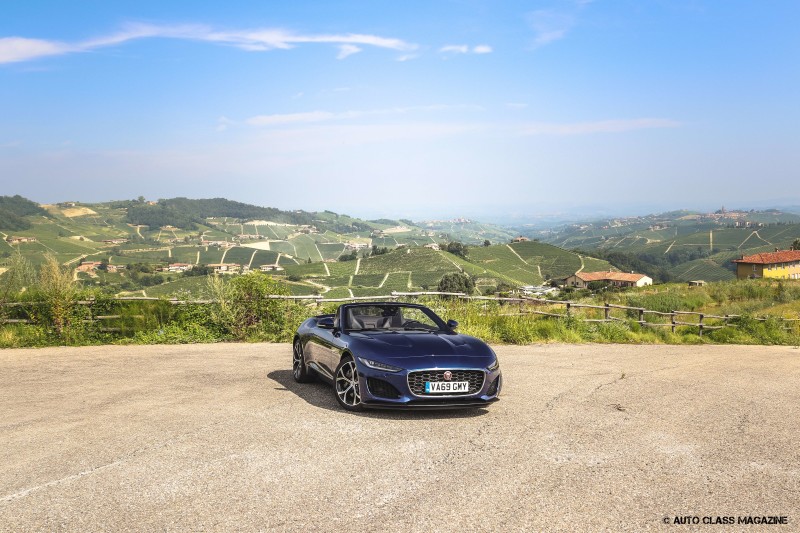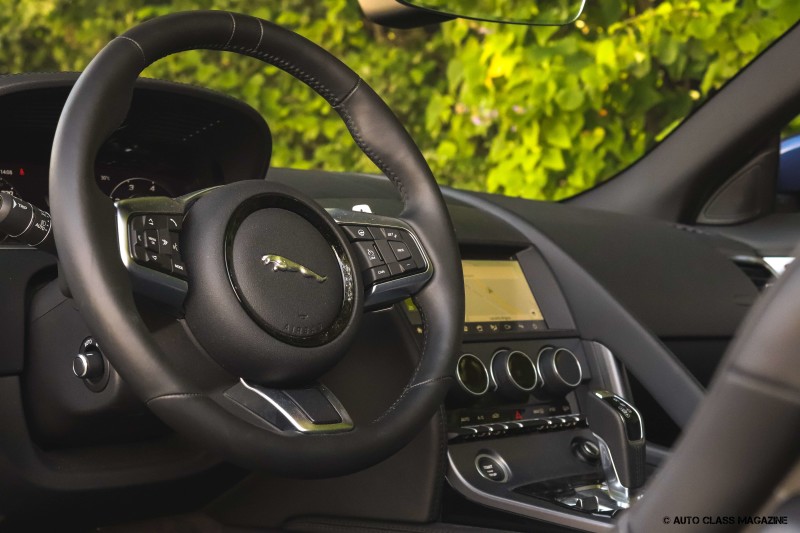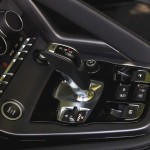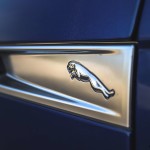The sun kisses its hips and its mouth does the same with the curves that tuck through the vineyards around Barolo, letting the smells of a fertile nature ready to offer the fruits of a culture with illustrious traditions enter the interior made of leather and Alcantara.
Words by Alessandro Marrone / Photos by S. Lomax
In 2013, the Jaguar from Coventry gave birth to its ransom model. The F-Type, both coupe and convertible collected some distinctive features of an ancestor of fundamental importance for Jaguar (the legendary E-Type) and sewed them on a two-seater with a strong image and solid on road skills, those that allow you to cross continents thanks to a remarkable ride comfort, but without leaving home the desire to have fun. There were several engines that took place under the hood of the legitimate heir of the legend, baptized with the letter immediately following that of its noble predecessor, and as we recently lost the supercharged 6-cylinder, leaving the possibility to choose between the powerful 450 and 575 horsepower V8s, or the more efficient 4-cylinder 2-liter with 300 horsepower, available for now with rear-wheel drive only.
7 years have passed and after a soft restyling, the F-Type is ready to change its skin. In reality it does so in a very subtle way, with aesthetic interventions that fortunately do not distort the sensual image of the British sports car, who maintains not only practically identical dimensions, but the characteristic that since the dawn of time defines a mature grand tourer: driving seat practically sitting on the rear wheels and a long front hood, which in this case houses a turbocharged engine of just 1,997 cc. If you cannot breathe changes in the passenger compartment, except for the digital cockpit and a necessary update to the multimedia system, externally we find a sharper tail and much thinner headlights that unlike those of the previous generation develop horizontally, giving a more slender image thanks to the new and more flattened front grille.
So I find the key in my hands and after covering the first kilometers that allow me to leave behind the traffic of Milan and the intersections clogged with boring city cars and looks that try in every way to figure out what car this is, I start to notice how much sobriety is in fact one of its many qualities that if only there were a little more imagination on the streets, it would allow it to go completely unnoticed. Once passed a motorway section that confirms the excellent soundproofing of the passenger compartment, it is finally time to fold the roof into the extremely sacrificed luggage compartment – an operation that can also be accomplished with the car moving – and enjoy the rays of a splendid summer day that illuminates the cultivated balconies of the Langhe region in Piedmont. Instinctively, I immediately activate the selector that manages the car’s dynamics, moving it to Dynamic and finding how the steering increases its resistance and the gearbox is more inclined to keep lower gears, in case you need more engine revs for overtaking. Likewise, the exhaust valves try to gain a few decibels, but the final yield is rather subdued. I move the gear lever into manual and so I decide the gears to be used through the aluminum paddles, another positive aspect that its direct rivals often do not have, preferring small plastic levers that also look cheaper.
The gearbox, once in manual mode, really allows you to decide how to set the driving experience, without intervening and overriding the driver and really let you keep control of the dynamics. There are only two seats, a beautiful blue sky above the head and 300 horses to ground on the rear axle: more than enough to make my days behind the wheel of the new F-Type engaging, but this time we must not let our prejudices on turbocharged engines make us think that we only need to put the right foot down and let the snail under the bonnet to keep us away from Newton-meters trouble. 300 horsepower still is a respectable power, especially under a large car body (192 cm), all in all with a short wheelbase (262 cm). The F-Type, however, weighs 1,615 kg, which then adding the weight of the two people on board, a full tank of petrol and the few tiny bags you can stow in the narrow rear compartment, weigh down the dynamics of the car. Luckily the 4-cylinder has an excellent torque reserve, in fact 400 Nm are available practically as soon as you put the throttle on the floor, but the maximum power of 300 horsepower is substantially delivered when the tachometer needle reaches 5,500 rpm. It is for this reason that the first few times you wait for a scratchy paw, you could be almost disappointed, also because of a really shy soundtrack. If, however, you move your perspective and really understand how this engine works, especially with the gearbox in manual mode, the story changes and then you will be able to find yourself in the hands of a fun and even more responsive convertible than the entry-level models in the price list of the previous generation.
In fact, through tight corners you can push with more confidence and even if the visibility on the front three quarters is sometimes compromised by the pillars, sometimes by the rear view mirror, you learn to take measurements after just a few kilometers. If then the weight is no longer perceived as a handicap, at least as it concerns the dialogue with a red line that reaches 6,400 rpm, it is during the most sudden direction changes that you feel how the chassis remains more devoted for comfort, never transforming the 2-liter F-Type in the sports car you will have at your disposal with the bigger engines available. Not at all nervous, almost sly, but capable of elevating driving pleasure from the moment you put the front wheels out of the backyard. The sun kisses its hips and its mouth does the same with the curves that tuck through the vineyards around Barolo, letting the smells of a fertile nature ready to offer the fruits of a culture with illustrious traditions enter the interior made of leather and Alcantara and which features two comfortable seats with perfect lateral restraint.
No, it never feels nervous, never grouchy (not even in the wet, where I recommend the use of the appropriate driving mode for slippery surfaces) and after a few days I finally understand the mistake I was making approaching it. I take the faithful notepad and begin to cross out some inputs I had put aside for writing this article. The centerpiece of this 2-liter is not to represent a sports car obsessed with performance and it does not matter if a 718 Cayman of equal power takes about 1 second less on the 0-100. The point is precisely this one, the F-Type with the 4-cylinder pot is a sweet tamed cat, moreover I believe that if your goal is raping its rubber, the 575-hp R is more than enough for getting the job done. You do not travel harpooned at the wheel, but rather leaning, steering with gentleness, with the left arm out of the window and the look that can distinguish what is around and must not sacrifice the panorama, frantically staring at the horizon in an agitated race against your own self-preservation spirit.
But there is that moment when I really needed a few more horses, a pinch of arrogance at low revs that would have been able to move it with arrogance. On the other hand, I could have given up those 30/50 extra horses, for a setting that made the chassis more rigid, thus turning the behavior of the F-Type more nervous between fastest corners. And if usually this cavalry allows you to be pushed to the limit, even if you are not a professional driver, when things went serious traction control intervened on several occasions. Deactivating it, the reduced weight of the 4 cylinder allows a better, or I should say easier maneuverability when the rear axle gave free rein to the tires, demonstrating how Jaguar actually managed to find a favorable point for any objection you could move towards the choice of an engine with such small volume.
While in my head some scenarios and ideas begin to emerge on where to drive the following days at my disposal with this domestic feline, I start to sum up things, something necessary especially given the numerous requests and questions addressed to me during the test drive period. The F-Type has succeeded in the difficult task of updating its look, while remaining faithful to the iconic style of the previous generation and therefore keeping contact with the famous E-Type. From a technical point of view, we are no longer unprepared and in fact we have become accustomed finding 2-liter units even on luxury brands, noting how the performance and fuel consumption benefit from downsizing at least as much as our wallet. In this case, the 300 horsepower 2.0 is not a furnace ready to push the British convertible at breakneck speed on some mountain road, but rather a more reasoned solution for those who really want to take advantage of the beautiful image of a mature car and that regardless of the body – I mean a solid roof or a folding fabric top – offers a relaxing driving experience brilliant enough to satisfy most of its customers.
You’d probably prefer to cruise with the roof folded down, forgiving a luggage compartment that will hardly satisfy the needs for a weekend out of town and with the 4-cylinder turbo proving to be domesticated and softened, especially ready to act well with a frame and suspensions that at the end of the day will have joined you on a panoramic excursion. It is not the new F-Type, it is this particular F-Type, the one that instead of muscles and claws prefers a more peaceful and relaxed behavior, accentuating the GT spirit that we have appreciated in Jaguar for decades, this time without having to spend too much time at the fuel pump. Its 300 horses move it from 0-100 kph in about 5.7 seconds, while top speed is 250 per hour, but the 400 Nm of torque is its most important number, the one that will limit the wait during delivery and not so much because of having a turbo under the hood, but because of the weight you carry with you. With prices that start from € 73,500 and rises at least up to € 76,270 for the R-Dynamic spec which then adds bumpers and other more sporty details, the Convertible version therefore costs almost € 8,000 more than the Coupe variant.
And finally here comes the fateful question, the one I would never expect to find in the middle of my time with this Jag. With 450 or 575 horses you don’t need many words, in fact it is perhaps better that your mouth opens wide in a mixture of hysterical amazement, but with 300 and such a docile set-up I often found myself mixing up ideas, appreciating how after so many happy moments this is a car able to keep me awake at night. Yes, because after all every excuse was good for getting out and drive, grinding miles, draining the tank and trying to understand how much I loved or hated this 2-liter. I did not want to leave anything to chance, the wonderful Langhe have given me memorable days immersed in an uncontaminated corner of Italy and where time seems to stand still, where the hours are marked by a lifestyle so distant from that of the city or from the one where I decided to bring the F-Type the following day. I needed the right path, curves that don’t care about golf clubs or cocktail’s break with friends. There, I would have let this cat to show off its claws and show that despite being a sensual baby grand tourer, it is also capable of attacking and leaving its mark, just like its bigger sisters.
DO NOT MISS THE SECOND PART OF OUR DRIVE.
LOOK FOR IT ON OUR BOOK. “ALPINIST” WILL COME OUT ON DECEMBER 2020!
JAGUAR F-TYPE CONVERTIBLE
Layout – front-engined, rear wheel drive
Engine – 4 cylinder 1.997 cc – turbo
Transmission – 8-speed automatic gearbox
Power – 300 hp @ 5.500 rpm
400 Nm @ 1.500 rpm
Weight – 1.615 kg
Acceleration – 5,7 sec.
Top Speed – 250 kph
Price – from € 73.500


